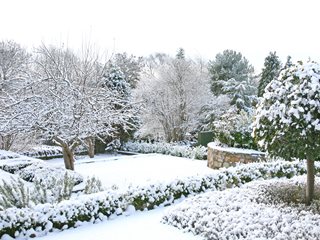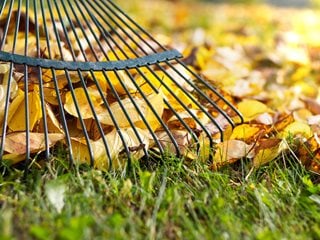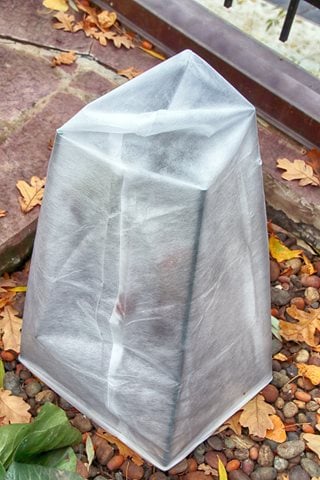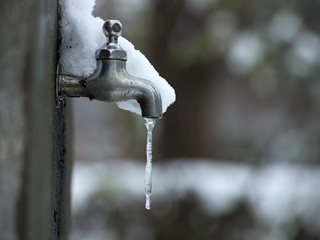How to Prepare Your Garden for Winter

Photo by: tazzymoto / Shutterstock.
In mid-to-late fall, gardeners in colder climates start thinking about winter; not necessarily because they’re looking forward to it, but because they know that without proper precautions, cold temperatures, drying winds and snow cover can all cause problems in their landscape. Plants can get windburn, tree branches can be broken from snow load, and sprinkler systems can be destroyed from a prolonged freeze. Winterization doesn’t have to be difficult though — most of the tasks fit into a regular course of maintenance and contribute to a healthy landscape year-round.
Gardeners in warmer climates aren't completely off the hook. Although snow load may not be a concern, random freezes and cold winds can still take a toll on plants and trees. Local garden centers might not be well stocked with the proper supplies (like shrub covers), so planning ahead and having a few things on hand can come in handy.
GENERAL PREPARATION:

Photo by: Encierro / Shutterstock.com.
- Weed the garden: One final weeding done late in the season can help eliminate hundreds of overwintering seeds that will just be waiting sprout in spring. Learn more about how to get rid of common garden weeds.
- Remove debris: Clear fallen leaves and other debris from lawns and beds to decrease the potential for overwintering pests and diseases. Clean, dry leaves (not those from diseased trees or shrubs) can be shredded and used as mulch. Gather leaves and put them through a leaf shredder or simply run over them with a lawnmower with a bag attached. Shredding the leaves prevents them from packing together in layers, and allows for better air circulation and water to flow through.
- Guard against deer: When there is little left to eat, deer will eat just about anything. Increase your efforts to protect your plants from deer. Here are some ways to make your garden more deer-resistant.
SHRUBS, PERENNIALS AND TREES:
Landscaping with native and other well-adapted plants can help minimize the care needed to keep your landscape healthy. However, plants don’t develop their full cold hardiness until they’re mature, and newer plants may need a couple years to reach their full cold-hardy potential. In the meantime, provide these younger plants with some extra protection.
- Prune lightly: Cut back any perennials that aren’t desired over winter: plants that will blacken and turn mushy, like Veronicas or geraniums; ones that tend to harbor disease or insects over winter, like peonies, bearded iris and members of the mint family; and those that just don’t provide attractive winter interest. Cut back weak or spindly branches that might be damaged with snow load, and crossing branches that can be damaged from rubbing in high wind. Trim long canes on roses to keep them from snapping. This should be done once perennials have gone dormant, which is usually after a few killing frosts. Depending on the pruning requirements for each variety, any major pruning should be left for another time, usually spring or summer.
- Wrap delicate and newly planted shrubs: Evergreen shrubs are mainly damaged from dry winter winds that cause dehydration and are much more prone to winter damage than deciduous varieties. Shrubs with weak, brittle or floppy branches, or those with leaves that are easily damaged should be wrapped with breathable fabric. Inexpensive burlap can be used or there is a variety of products, like these shrub covers, designed specifically for protecting bushes and small trees.
- Protect hedges: To shield a row of shrubs, you can either wrap the entire row or create a windbreak on the prevailing wind side with stakes and a length of protective fabric or dense shade cloth.
- Water: Root systems of newly planted bushes and trees aren’t established enough to readily replace water lost from dehydrating winter winds. Continue to water them regularly until the ground freezes and use mulch to help retain moisture. Give all your plants one last deep watering. They’ll need this extra moisture to get through the winter when they have difficulty getting water from frozen ground.
- Lighten the load: Plants located under eave lines may get more than their fair share of snow due to roof-shed. Build teepee structures over these plants to deflect this extra load and keep branches from breaking.
- Use an anti-transpirant: Protect evergreens from drying winter winds with sprays like Wilt Pruf. Applied to the leaves, it reduces moisture loss and defends against dehydration and wind burn.
- Apply mulch: An insulating layer of mulch can help dormant perennials survive the winter with little or no damage when applied after the ground has already frozen. “Dormant perennials cope better with consistent cold, rather than rapid temperature fluctuations and the resulting cycle of freeze, thaw, and re-freeze,” writes Traci DiSabato-Aust, author of The Well-Tended Perennial Garden.

Photo by: Photowind / Shutterstock.com.
CONTAINER PLANTS:
- Select hardier plants: Plants and trees grown in containers are at a disadvantage to those grown in-ground. The above-ground portion of the plant may have reached its full hardiness, but the roots are more vulnerable to freezing without the full benefit of in-ground insulation. Even if a plant is hardy for your zone, choosing one that is hardy one to two zones lower can help it survive when grown in a container. Larger containers also offer better insulation with a greater volume of soil.
- Bring them in: Tender perennials and tropical plants can be moved indoors where they will get bright light. Relocate half-hardy perennials to a basement or garage where they will go dormant. Plants that need a chilling period in order to bloom or set fruit should be left outside and protected. Get more tips on plants that are suitable for over-wintering indoors.
- Bury your containers: If you have space, containers can be left intact and planted in the ground. This provides the same insulation as in-ground planting.
- Protect your plants: Huddle plants together, placing the most cold-sensitive ones in the center. Locate the grouping in a sheltered area against a building or structure. Provide protection from wind with a windbreak or screen.
- Protect your containers: Wrap terra cotta pots with layers of bubble wrap and burlap. Cover with plastic wrap to prevent further absorption of moisture. Turn empty pots over to keep water from collecting and freezing, and cover those that are too large to flip or relocate.
LAWNS:
- Apply a fall fertilizer: Get your lawn ready for winter with an organic fertilizer that is high in potassium, like Espoma Fall Winterizer.
- Cut the grass short: The last mow of the season should be 2 to 3 inches tall; this will keep it from sheltering fungal diseases when covered with snow.
- Add lime: Horticultural lime makes soil more alkaline, which is preferable for lawns. The freeze thaw cycle of winter helps break-down the pellets and work it into the soil.
SPRINKLER SYSTEMS:
- Unplug the timer: Timers can sustain damage from power surges during winter storms, so it’s better to unplug them rather than just turn them off.
- Blow out the system: Irrigation systems in cold climates should be installed with periodic outlets that allow you to blow any remaining water out of the pipes with an air compressor to prevent damage from freezing.
- Clear water from hose bibs: Shut off the water at the source, then run the faucet to drain all water from the pipe.

Photo by: Dongseun Yang / Shutterstock.com.
OUTDOOR LIVING FEATURES:
- Shut off gas lines: If you live in an area where you need to winterize, then you’re probably not going to be using your outdoor kitchen or gas-fueled fire pit until spring. Outdoor gas lines will usually have a shut-off lever at the house, and it’s a good idea to shut off the gas to prevent leaks due to winter damage.
- Drain faucets: Similar to a hose bib, turn off the water at the source and open the faucet to drain any remaining water.
- Clear drains: To prevent damage from trapped water freezing in the drain of an outdoor sink, pour a little plumbing antifreeze down the drain to keep it from freezing.
- Protect furniture: Bring patio furniture indoors, or use fitted covers to protect it outdoors over the winter.
